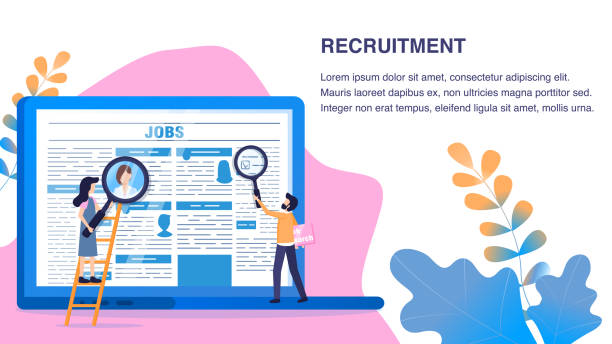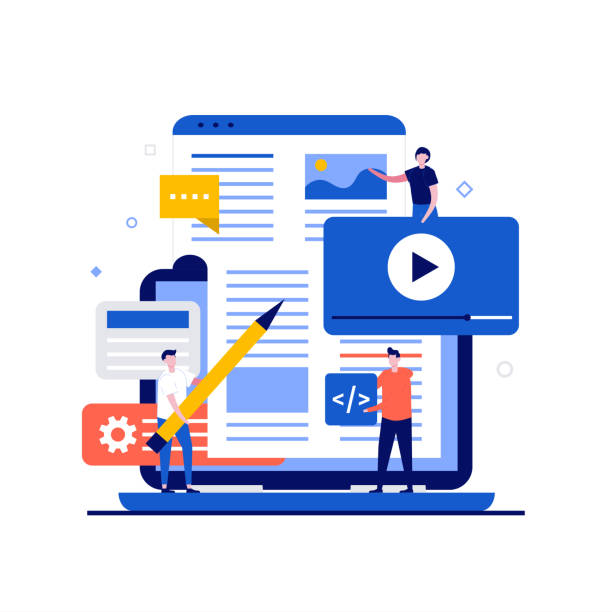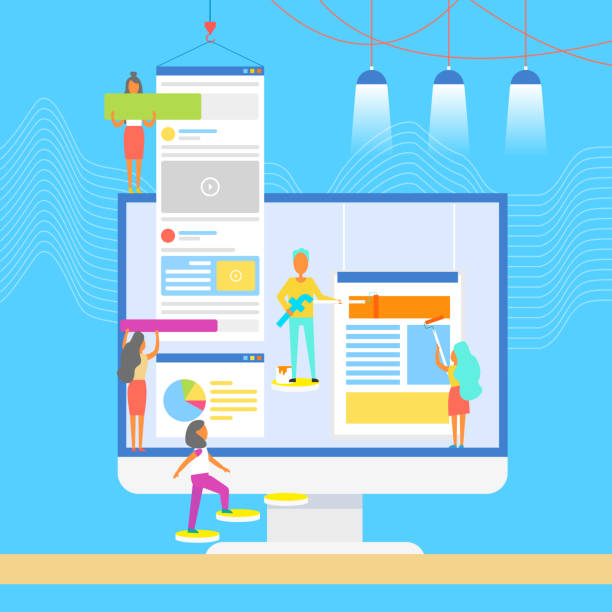The Importance of Speed in Modern Website Design

In today’s digital world, website speed is no longer a competitive advantage, but a vital necessity.
Visitors expect web pages to load in a fraction of a second; otherwise, they quickly move to competitor sites.
This issue is not limited to user experience; loading speed directly impacts SEO and site ranking in search engines.
Google and other search engines prioritize faster websites, believing they offer a better user experience.
Therefore, if you are looking to increase traffic, improve search result rankings, and ultimately boost conversion rates, fast website design must be at the forefront of your web development plans.
#User_experience, #SEO, and #conversion_rate are the three main pillars directly affected by website speed.
Today’s users are impatient, and a slow website can lead to the loss of potential customers.
According to research, every second of delay in page load time can lead to a significant decrease in conversion rates.
This is particularly evident for e-commerce websites, where every click and every second is vitally important.
Furthermore, site speed also affects search engine crawlability; slower websites may be visited less frequently by search bots, which can lead to incomplete content indexing or slow updates for new pages.
Therefore, investing in high-speed website design is not just a technical measure, but a smart business strategy that will significantly contribute to your business’s sustainable growth.
Speed is indeed the foundation of a successful website in the digital age, and neglecting it can incur significant costs.
Do you dream of a thriving online store but don’t know where to start?
RasaWeb is your comprehensive e-commerce website design solution.
✅ Attractive and user-friendly design
✅ Increased sales and revenue⚡ Get free consultation
Key Factors Affecting Site Speed

To achieve fast website design, it is essential to understand the main factors affecting website performance.
These factors encompass a wide range of technical aspects, from code structure to server infrastructure.
One of the most important factors is Server Response Time.
If your server is slow, regardless of the optimization level of client-side code, your website will never achieve optimal speed.
Choosing a powerful hosting service suitable for your website’s needs is the first step in this direction.
#Hosting, #images, and #coding are three fundamental factors that directly affect loading speed.
Optimizing images and other media also plays a significant role.
Large images without proper compression can drastically reduce loading speed.
Using modern image formats like WebP and applying compression techniques and Lazy Loading are effective solutions in this regard.
Furthermore, optimized coding and the compression of CSS and JavaScript files are highly important.
Excessive code, inefficient functions, and render-blocking scripts can all lead to a slow website.
Using a CDN (Content Delivery Network) is also a powerful solution to reduce content loading time for users in different geographical locations, as content is delivered from the server closest to the user.
Caching, or temporary data storage, also makes pages load faster for subsequent visits, as the browser will not need to re-download all resources.
Ultimately, every aspect of a website, from the plugins and themes used to even the chosen fonts, can impact overall performance.
Therefore, to achieve fast and optimized website design, it is necessary to adopt a comprehensive and multifaceted approach and carefully review and improve all these factors.
Optimizing Images and Media for Faster Speed

Images and media content constitute a large portion of web page size, and therefore, optimizing them is one of the most effective steps towards fast website design.
High-quality and large-dimension images, while visually appealing, can significantly reduce page loading speed.
To address this issue, using modern image formats like WebP, which offer much better compression while maintaining quality, is recommended.
Also, compressing images before uploading and using online tools or CMS plugins for this purpose is crucial.
#Image_format, #compression, and #lazy_loading are key concepts in media optimization.
Lazy Loading is also a powerful tool that ensures images and videos are loaded only when the user scrolls to the relevant section of the page.
This method prevents the simultaneous loading of all media at the beginning and significantly reduces the First Contentful Paint (FCP) time.
There are many tools available for compressing images without a noticeable loss in quality, which can assist you in this process automatically or manually.
For instance, tools like TinyPNG or WordPress plugins such as Smush can dramatically reduce image file sizes.
In addition to images, videos and audio files should also be optimized.
Using appropriate video formats (like MP4 with H.264 codec) and hosting them on specialized platforms like YouTube or Vimeo instead of directly on your own server can offload a significant burden from your server and contribute to achieving fast website design.
Below, you will find a comparative table of different image optimization methods:
| Optimization Method | Description | Impact on Speed |
|---|---|---|
| Using WebP format | Modern image format with higher compression and good quality. | Significant reduction in file sizes, faster loading. |
| Lossy/Lossless Compression | Reduces file size with or without visual quality loss. | Reduced file size, improved download speed. |
| Lazy Loading | Loads images only when they are within the user’s viewport. | Reduced initial page load time and improved FCP. |
| Specifying image dimensions | Defining the width and height of the image in the HTML tag. | Prevents layout shift and improves CLS. |
The Role of Hosting and Infrastructure in Fast Website Design

One of the fundamental pillars for achieving fast website design is the correct choice of hosting and suitable infrastructure for your website.
Many speed-related issues stem not from the website’s code, but from the slowness or inefficiency of the hosting server.
Server response time, available bandwidth, and the geographical location of the server are all crucial factors that directly impact page loading speed.
#Web_hosting, #CDN, and #server are fundamental concepts in this area.
The choice between hosting types such as Shared Hosting, Virtual Private Server (VPS), or Dedicated Server should be based on your website’s anticipated traffic and resource requirements.
Shared hosting is usually suitable for small websites with low traffic, but if traffic increases, a noticeable slowdown may occur due to resource sharing with other websites.
VPS and dedicated servers offer more control over resources and server configuration and are better choices for websites with medium to high traffic.
Using a Content Delivery Network (CDN) is a very effective solution to increase loading speed for global users.
A CDN stores your website’s static content (such as images, CSS, and JavaScript) on various servers around the world, and when a user visits your website, the content is delivered to them from the closest CDN server, which drastically reduces loading time.
Additionally, using servers that support new protocols like HTTP/2 (and in the future HTTP/3) can help improve performance.
Proper server configuration, utilizing Server-Side Caching, and database optimization also play crucial roles in reducing server response time and consequently increasing overall website speed.
A powerful CDN can offload the burden from your main server and provide a more integrated and faster user experience for your visitors worldwide, which in turn helps improve SEO ranking and user satisfaction, and contributes to fast website design.
Does your current website reflect your brand’s credibility as it should? Or does it drive away potential customers?
RasaWeb, with years of experience in professional corporate website design, is your comprehensive solution.
✅ A modern, beautiful website tailored to your brand identity
✅ Significant increase in lead generation and new customer acquisition
⚡ Contact RasaWeb now for a free consultation on corporate website design!
Optimizing Code and Scripts for High Performance

Optimizing HTML, CSS, and JavaScript codes is one of the most important steps in achieving fast website design.
Excessive, unused, or unoptimized code can significantly increase page load time and disrupt the user experience.
This stage involves cleaning and compressing codes, and properly managing how scripts and styles are loaded.
#CSS_code, #JavaScript, and #code_optimization are the main concepts in this area.
Minification means removing whitespace, comments, and extra characters from CSS and JavaScript files, which reduces file sizes and thus leads to faster loading.
In addition to minification, concatenating files can also reduce the number of HTTP requests, although its importance has lessened with the advent of HTTP/2.
For CSS files, placing critical and initial CSS codes in the <head> section of the HTML document and asynchronously loading the rest of the CSS files can improve the First Contentful Paint (FCP) time.
Regarding JavaScript, the best approach is to defer loading scripts or use the `async` attribute for them.
This allows the browser to render the main content of the page without waiting for scripts to load and execute.
Scripts that are not essential for initial page functionality should be placed at the end of the <body> tag to prevent them from blocking content rendering.
Furthermore, it is recommended to avoid excessive use of JavaScript frameworks and libraries where large portions are not utilized.
JavaScript that is heavy and unoptimized can create serious bottlenecks in the path to fast website design.
Continuously reviewing website codes and removing any dead code or unnecessary plugins also helps maintain optimal performance.
These actions not only increase site speed but also result in a cleaner and more maintainable codebase.
Using Content Management Systems and Site Speed

Content Management Systems (CMS) such as WordPress, Joomla, and Drupal, significantly simplify the process of building and managing websites.
However, improper use of them can have a considerable negative impact on site speed.
The question is: are CMSs inherently slow? The answer is that the CMS itself is not solely to blame; rather, how it is used and configured plays a key role in achieving fast website design.
#CMS, #WordPress, and #plugins are the three main challenges and opportunities in this area.
Many speed issues in CMSs stem from excessive and unoptimized use of plugins and themes.
Each plugin installed may add extra CSS, JavaScript code, or database requests to your website, which over time can lead to severe slowdowns.
Choosing lightweight and optimized themes and using the minimum number of essential plugins are among the first steps to maintain site speed in CMSs.
Additionally, proper caching configuration in the CMS, such as using powerful caching plugins in WordPress (like WP Super Cache or LiteSpeed Cache), can dramatically increase page loading speed.
These plugins create static versions of your web pages so that the server doesn’t need to reprocess every request.
Database optimization is also crucial in CMSs.
Large and unorganized databases can increase server response time.
Regular use of database optimization tools (like the WP-Optimize plugin in WordPress) to remove temporary data and optimize tables is essential.
Furthermore, ensuring that the CMS, theme, and plugins are up-to-date for security and performance is important.
Finally, educating users on uploading optimized images and producing efficient content can also help maintain site speed in the long term.
By observing these points, one can leverage the power and flexibility of CMSs while achieving fast and efficient website design.
Tools and Techniques for Speed Testing and Monitoring

After applying optimizations for fast website design, the next stage is regular measurement and monitoring of website performance.
Without appropriate tools, identifying bottlenecks and evaluating the effectiveness of changes will be difficult.
These tools provide valuable insights into areas that need improvement and help you continuously enhance the user experience.
#Speed_tools, #Google_PageSpeed, and #GTmetrix are three prominent tools in this field.
Google PageSpeed Insights is one of the most widely used tools, providing performance scores for your site’s mobile and desktop versions and offering specific recommendations for speed improvement.
This tool focuses on Google’s Core Web Vitals metrics, which are crucial for SEO.
GTmetrix is another tool that provides more comprehensive information, including a Waterfall Chart, which shows how long each resource on your website takes to load.
This chart helps identify render-blocking resources or slow requests.
Lighthouse, embedded in Chrome’s developer tools, is also a powerful tool for analyzing performance, accessibility, best practices, and SEO.
Using these tools should be an integral part of your website’s development and maintenance process.
Additionally, continuous monitoring of website speed using automatic tools (such as UptimeRobot or Pingdom) can alert you to any sudden drops in speed.
Accurate analysis of these tools’ reports and understanding the meaning of each metric (such as FCP, LCP, CLS) will help you perform targeted optimizations.
Website speed optimization is an ongoing process, and these tools will be your guide along this path.
Below, you will find a comparative table of these tools and their main focus:
| Tool Name | Main Focus | Key Features |
|---|---|---|
| Google PageSpeed Insights | Core Web Vitals and user experience | Speed score (mobile and desktop), improvement suggestions |
| GTmetrix | Overall performance and deep debugging | Waterfall Chart, Video Playback, History |
| Lighthouse (Chrome DevTools) | Comprehensive audit (Performance, SEO, Accessibility, PWA) | Detailed reports, various Audits |
| Pingdom Tools | Load time and requests | Global test locations, Performance Grade |
The Impact of User Experience on Speed and Visitor Engagement

Website speed is not just a technical metric; it plays a vital role in the overall user experience (UX).
A fast website design directly impacts how visitors interact with your content, their retention on the site, and their willingness to return.
Perceived speed, meaning the speed felt by the user, is sometimes even more crucial than actual speed.
#UX, #visitor, and #perceived_speed are important concepts closely related to website speed and design.
When a user clicks on a link and the page loads instantly, they feel satisfied.
This positive experience increases the likelihood of them continuing to browse the site, consuming more content, and even taking a desired action (such as making a purchase or filling out a form).
Conversely, a slow website leads to user frustration and quick abandonment.
This rapid exit results in a high “Bounce Rate,” which sends a negative signal to search engines and harms the site’s SEO.
From a psychological perspective, even small delays (less than a second) can negatively impact users’ perception of your website and brand.
Users expect websites to be instantly responsive, and in the age of mobile phones and high-speed internet, this expectation has only grown.
Therefore, speed optimization goes beyond just technical aspects; it means understanding user expectations and delivering an exceptional user experience.
Displaying initial visual elements, even if incomplete, in the first moments of loading can give the user the feeling that the website is working and keep them engaged until the page fully loads.
This technique is called “perceived speed.”
Ignoring speed in user experience design is like building a beautiful building on a weak foundation; it will eventually collapse.
Therefore, paying attention to speed and its impact on UX is crucial not only for SEO but also for retaining and growing your audience.
Does your current website build the trust that potential customers should have in your business? If not, it’s time to have a professional and impactful corporate website with RasaWeb.
✅ Fully custom design tailored to your brand identity
✅ Increased lead generation and business credibility in the eyes of customers⚡ Contact us for a free consultation!
The Future of Fast Website Design and Emerging Technologies

The world of the web is constantly evolving, and new technologies are continuously being introduced to increase speed and efficiency.
For those seeking fast and lasting website design, awareness of these future trends is crucial.
These technologies can offer innovative solutions to overcome web speed challenges.
#AMP, #PWA, and #new_technology are three of the most important future trends in this field.
Accelerated Mobile Pages (AMP) is an open-source project by Google that enables websites to create extremely lightweight and fast versions of their pages that load instantly in search results, especially on mobile devices.
This technology is specifically designed for mobile content consumers.
Progressive Web Apps (PWA) is another technology that offers a combination of the best features of websites and mobile applications.
PWAs can work offline, have push notifications, and can be installed on the user’s home screen, providing a user experience similar to a native app, while being accessible via a URL and not requiring download from app stores.
These features significantly increase speed and user engagement.
The HTTP/3 protocol, built on QUIC, is also another significant advancement in web infrastructure.
This protocol is designed to reduce latency and improve performance on unstable networks and will soon replace HTTP/2.
Additionally, the use of Artificial Intelligence (AI) and Machine Learning (ML) for automatic website optimization, traffic prediction, and server resource allocation is emerging.
These technologies can automatically compress images, remove unnecessary code, and even implement the best caching strategies.
Adopting and utilizing these emerging technologies not only helps you have an incredibly fast website but also places you at the forefront of web innovation, contributing to the long-term growth and sustainability of your online business.
A progressive website is one that constantly seeks to use these innovations for continuous improvement in user experience and loading speed.
Conclusion and Practical Steps for a High-Speed Website

Achieving fast website design is not a one-time project, but an ongoing process that requires continuous attention and optimization.
In this article, we discussed the importance of speed, its influencing factors, image and code optimization methods, the role of hosting and CMS, as well as testing tools and future technologies.
Now it’s time to translate this knowledge into practical steps.
#Speed_strategy, #continuous_optimization, and #technical_SEO are our three concluding keywords.
To begin, evaluate your website’s current status with tools like Google PageSpeed Insights and GTmetrix to identify key weaknesses.
Then, apply optimizations in order of priority.
Start by focusing on optimizing images and media, as this usually has the greatest impact with the least effort.
After that, move on to compressing and optimizing codes (HTML, CSS, JavaScript).
Ensuring that your hosting is powerful and suitable and that you are using a CDN are crucial next steps.
If you use a CMS, be sure to use strong caching plugins and minimize the number of your plugins and themes.
After implementing any significant change, re-test your site’s speed to measure its impact.
Remember that regular monitoring of website performance is key to maintaining speed in the long run.
The web world is constantly changing, and what is considered fast today might be deemed slow tomorrow.
Therefore, you should always stay updated with the latest technologies and best practices.
The ultimate goal is to provide an unparalleled user experience that not only satisfies your users but also leads to better search engine rankings and ultimately the success of your online business.
By focusing on fast website design and continuous optimization, your website can become a powerful asset in the digital world.
These solutions are crucial not only for web developers but also for online business owners to succeed in today’s competitive landscape and have a successful website.
Frequently Asked Questions
| No. | Question | Answer |
|---|---|---|
| 1 | What does fast website design mean? | Optimizing a website for quick page loading, improved user experience, and SEO ranking. |
| 2 | Why is site loading speed important? | Increases user satisfaction, reduces bounce rate, improves SEO, and boosts conversion rates (sales/actions). |
| 3 | What tools are available for testing site speed? | Google PageSpeed Insights, GTmetrix, and Pingdom Tools are common tools. |
| 4 | What are the main causes of a slow website? | Unoptimized images, heavy JavaScript and CSS codes, poor hosting, and lack of caching. |
| 5 | What is “Caching” (Caching) and how does it help site speed? | Temporary storage of site data in the user’s browser or server for faster loading on subsequent visits. |
| 6 | How to optimize images to increase site speed? | Reducing image size (compression) without significant quality loss, using modern formats (WebP), and setting appropriate dimensions. |
| 7 | What role does CDN (Content Delivery Network) play in fast website design? | Distributing website content across various servers worldwide to deliver content from the closest server to the user. |
| 8 | Does choosing suitable hosting affect site speed? | Yes, quality hosting with powerful servers is essential for fast site loading. |
| 9 | What is the Minification technique and why is it used? | Removing extra characters (whitespaces, comments) from HTML, CSS, JavaScript codes to reduce file sizes. |
| 10 | What is the relationship between responsive design and site speed? | Responsive design means correct display on different devices; if not implemented correctly, it can create extra load and reduce speed. Responsive optimization is important for speed. |
And other services of Rasa Web Advertising Agency in the field of advertising
Smart Conversion Rate Optimization: A dedicated service for growth in SEO ranking improvement based on real data.
Smart Content Strategy: A professional solution for campaign management focusing on marketing automation.
Smart Marketing Automation: A dedicated service for growth in website traffic increase based on Google Ads management.
Smart Advertorial: Professional optimization for customer behavior analysis using marketing automation.
Smart SEO: A fast and efficient solution for increasing website traffic with a focus on attractive user interface design.
And over a hundred other services in internet advertising, advertising consultation, and organizational solutions
Internet Advertising | Advertising Strategy | Advertorial
Sources
Website Design Guide in Parsi Code Latest Website Design Trends in Webgardy The Importance of Website Design in Iran Naming Fast Website Development in Noshka
? For your business to shine and reach its peak in the online world, RasaWeb Afarin Digital Marketing Agency is always by your side, offering comprehensive services including WordPress website design, SEO, and social media management.
📍 Tehran, Mirdamad Street, next to Bank Markazi, Southern Kazeroon Alley, Ramin Alley, No. 6



